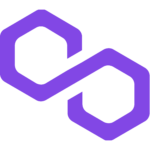Polygon or Matic Network is the “Ethereum’s internet of blockchains.” This framework is an interoperability and scaling network for creating blockchains that are compatible with Ethereum. Everyone knows Ethereum, and everyone wants to benefit from it. But while it is a popular hub for Defi development activity and running smart contracts, it suffers from severe limitations. Ethereum is not to connect with other blockchains. Suppose you have ever experienced participating in the Ethereum blockchain. In that case, you know that The real problem is High cast low transactions speed.
Polygon emerges as an excellent solution by providing a framework for building material in operable blockchains. Keep reading to understand what makes Matic Network a better alternative to Ethereum.
To Know Polygon, We Need To Know Ethereum.
Ethereum creates a place where code is the law. In this sense, developers translate the law into a mathematical equation. In other words, Ethereum provides users with a way to enforce property rights and regulations on the internet. Ethereum implements the rules by using a feature called Smart contracts. These contracts are just a piece of code that will execute when a specific condition meets.
What Are The Issues With Ethereum?
Ethereum has attracted a considerable number of investors and developers since 2013. When many developers and investors pay attention to a particular project, they put much pressure on that project. As you are sitting here reading this article, 361 billion dollars are locked in Ethereum. Every day, 1.2 million transactions happen in Ethereum. So it is pretty standard for Ethereum to get congested.
As the number of people using it increases, the Network gets slow, and its cost increases. The transaction fee on Ethereum in early 2021 was almost $100. Polygon Is a perfect solution for all these problems, which we will talk about more in the following.
What Is Polygon?
Polygon is the perfect solution for all Ethereum issues. With MATIC, there is no room for high fees, poor user experience, and low transaction throughput. Polygon wants to create Ethereum’s internet of blockchains.
In doing so, Polygon creates a framework to let developers build and launch their custom-designed Ethereum-compatible blockchain. In this framework, different blockchains can exchange information.
First, the framework was called Matic Network, and later, the founders renamed it Polygon. In the beginning, Matic was a simple solution for a scaling problem in Ethereum. At the same time, Polygon is a kind of infrastructure for a network of enormous scaling collaborative block trees that keep their self-sovereignty. Polygon uses a one-of-a-kind technology known as Plasma for processing transactions off-chain. In this process, the transaction will be offloaded from the main chain onto Polygon’s proof of stake chain. This will increase the number of confirmed transactions in the Network.
Who created Polygon?
A team of developers led by the full co-founders created Polygon in India in 2017. The four co-founders are Jayanti Kanani, Sandeep Nailwal, Anurag Arjun, and Mihailo Bjelic. The Network went live in 2020, and since then, it has attracted big names in the world of Defi, such as MakerDAO and Decentraland.
How Does Polygon Work?
Polygon aims to scale Ethereum thanks to a plethora of sidechains. It has four different layers: The Ethereum layer, the security layer, the Polygon layer, and the execution layer.
All the smart contracts that have been set on the Ethereum create the Ethereum layer of the Matic Network. These contracts manage all communication between Ethereum and Polygon chains.
The security level is another side chain of Polygon, which provides an additional layer of security for the network. Polygon layer is the ecosystem of Ethereum-compatible blockchain networks built on Polygon.
The Execution layer, known as Polygon’s Ethereum Virtual Machine or EVM, is responsible for executing smart contracts.
Suppose you are wondering about the definition of a sidechain; you should know that a sidechain is an independent blockchain that works alongside and associates with the main blockchain to provide additional capabilities and increased speed.
What Is a Polygon Token?
The native token of Polygon is MATIC. It is the main talking that can be used for exchange payments. On the other hand, it can be stored to protect the whole network. Following a massive expansion in use, the price of this token has increased.
MATIC, with the whole supply of 10 million tokens, is accessible on crypto exchange platforms like Bitunivex. It is possible to buy MATIC with both Fiat and crypto on the Bitunivex exchange.



